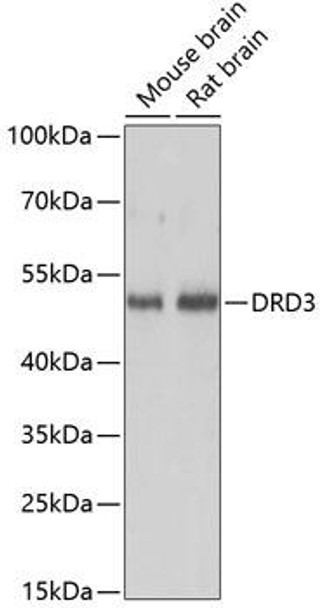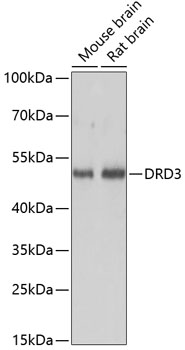Cell Biology Antibodies 5
Anti-DRD3 Antibody (CAB14622)
- SKU:
- CAB14622
- Product Type:
- Antibody
- Reactivity:
- Mouse
- Reactivity:
- Rat
- Host Species:
- Rabbit
- Isotype:
- IgG
- Antibody Type:
- Polyclonal Antibody
- Research Area:
- Cell Biology
Description
| Antibody Name: | Anti-DRD3 Antibody |
| Antibody SKU: | CAB14622 |
| Antibody Size: | 20uL, 50uL, 100uL |
| Application: | WB |
| Reactivity: | Mouse, Rat |
| Host Species: | Rabbit |
| Immunogen: | A synthetic peptide corresponding to a sequence within amino acids 1-100 of human DRD3 (NP_000787.2). |
| Application: | WB |
| Recommended Dilution: | WB 1:500 - 1:2000 |
| Reactivity: | Mouse, Rat |
| Positive Samples: | Mouse brain, Rat brain |
| Immunogen: | A synthetic peptide corresponding to a sequence within amino acids 1-100 of human DRD3 (NP_000787.2). |
| Purification Method: | Affinity purification |
| Storage Buffer: | Store at -20'C. Avoid freeze / thaw cycles. Buffer: PBS with 0.02% sodium azide, 50% glycerol, pH7.3. |
| Isotype: | IgG |
| Sequence: | MASL SQLS GHLN YTCG AENS TGAS QARP HAYY ALSY CALI LAIV FGNG LVCM AVLK ERAL QTTT NYLV VSLA VADL LVAT LVMP WVVY LEVT GGVW NFSR |
| Gene ID: | 1814 |
| Uniprot: | P35462 |
| Cellular Location: | Cell membrane, Multi-pass membrane protein |
| Calculated MW: | 40kDa/44kDa |
| Observed MW: | 44kDa |
| Synonyms: | DRD3, D3DR, ETM1, FET1 |
| Background: | This gene encodes the D3 subtype of the five (D1-D5) dopamine receptors. The activity of the D3 subtype receptor is mediated by G proteins which inhibit adenylyl cyclase. This receptor is localized to the limbic areas of the brain, which are associated with cognitive, emotional, and endocrine functions. Genetic variation in this gene may be associated with susceptibility to hereditary essential tremor 1. Alternative splicing of this gene results in transcript variants encoding different isoforms, although some variants may be subject to nonsense-mediated decay (NMD). |
| UniProt Protein Function: | DRD3: Dopamine receptor whose activity is mediated by G proteins which inhibit adenylyl cyclase. Promotes cell proliferation. Genetic variation in DRD3 is associated with essential tremor hereditary type 1 (ETM1). ETM1 is the most common movement disorder. The main feature is postural tremor of the arms. Head, legs, trunk, voice, jaw, and facial muscles also may be involved. The condition can be aggravated by emotions, hunger, fatigue and temperature extremes, and may cause a functional disability or even incapacitation. Inheritance is autosomal dominant. Belongs to the G-protein coupled receptor 1 family. 2 isoforms of the human protein are produced by alternative splicing. |
| UniProt Protein Details: | Protein type:Receptor, GPCR; Membrane protein, integral; GPCR, family 1; Membrane protein, multi-pass Chromosomal Location of Human Ortholog: 3q13.3 Cellular Component: cell projection; endocytic vesicle; integral to plasma membrane; apical part of cell; plasma membrane Molecular Function:dopamine D2 receptor-like receptor activity; protein domain specific binding; protein binding; dopamine binding; drug binding; D1 dopamine receptor binding Biological Process: synaptic transmission, dopaminergic; regulation of lipid metabolic process; prepulse inhibition; musculoskeletal movement, spinal reflex action; response to morphine; locomotory behavior; negative regulation of transcription from RNA polymerase II promoter; dopamine metabolic process; regulation of dopamine secretion; dopamine receptor, adenylate cyclase inhibiting pathway; learning and/or memory; behavioral response to cocaine; positive regulation of cell proliferation; renin-angiotensin regulation of blood volume; visual learning; negative regulation of blood pressure; circadian regulation of gene expression; negative regulation of sodium:hydrogen antiporter activity; dopamine receptor, adenylate cyclase activating pathway; response to drug; positive regulation of cytokinesis; positive regulation of dopamine receptor signaling pathway; negative regulation of protein secretion; negative regulation of protein kinase B signaling cascade; positive regulation of mitosis; regulation of cAMP metabolic process; response to amphetamine; negative regulation of adenylate cyclase activity; regulation of dopamine uptake; regulation of multicellular organism growth; social behavior; learning; arachidonic acid secretion; response to cocaine; regulation of circadian sleep/wake cycle, sleep; negative regulation of oligodendrocyte differentiation; cellular calcium ion homeostasis; G-protein coupled receptor protein signaling pathway; response to ethanol; negative regulation of dopamine receptor signaling pathway; acid secretion; G-protein coupled receptor internalization; positive regulation of transcription from RNA polymerase II promoter Disease: Schizophrenia; Tremor, Hereditary Essential, 1 |
| NCBI Summary: | This gene encodes the D3 subtype of the five (D1-D5) dopamine receptors. The activity of the D3 subtype receptor is mediated by G proteins which inhibit adenylyl cyclase. This receptor is localized to the limbic areas of the brain, which are associated with cognitive, emotional, and endocrine functions. Genetic variation in this gene may be associated with susceptibility to hereditary essential tremor 1. Alternative splicing of this gene results in transcript variants encoding different isoforms, although some variants may be subject to nonsense-mediated decay (NMD). [provided by RefSeq, Jul 2008] |
| UniProt Code: | P35462 |
| NCBI GenInfo Identifier: | 1169206 |
| NCBI Gene ID: | 1814 |
| NCBI Accession: | P35462.2 |
| UniProt Secondary Accession: | P35462,Q4VBM8, A1A4V5, |
| UniProt Related Accession: | P35462 |
| Molecular Weight: | 40,760 Da |
| NCBI Full Name: | D(3) dopamine receptor |
| NCBI Synonym Full Names: | dopamine receptor D3 |
| NCBI Official Symbol: | DRD3 |
| NCBI Official Synonym Symbols: | D3DR; ETM1; FET1 |
| NCBI Protein Information: | D(3) dopamine receptor; D(3) dopamine receptor; essential tremor 1 |
| UniProt Protein Name: | D(3) dopamine receptor |
| UniProt Synonym Protein Names: | Dopamine D3 receptor |
| Protein Family: | D(3) dopamine receptor |
| UniProt Gene Name: | DRD3 |
| UniProt Entry Name: | DRD3_HUMAN |







